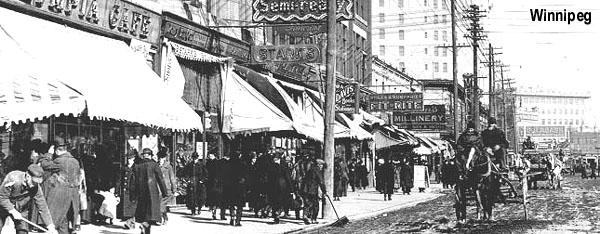

| Winnipeg:
The juction where the Red and Assiniboine Rivers meet was the birthplace of Winnipeg. In 1738, Pierre de La Verendrye began the fur trading settlement at this junction. The settlement, known as the Red River Colony, became a hub of the fur trade until the 1880s when grain production became more important in Western Canada. In 1862 Mr. McKenny built his store where the corner of Portage and Main St. are today. The name Winnipeg was first used for the area around Mr. McKenny's store in 1866. Winnipeg is the Cree name that means "Muddy Water". |
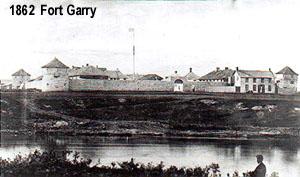
By 1872 Winnipeg swallowed up Upper Fort Garry and people came to Winnipeg because it was close to this Hudson Bay Post. |
| First Immigration:
The first people came by boat along the fur traders' routes from Churchill. People tried to build a wagon road from Fort William to Winnipeg but they only got 40 km in 11 years. The Dawson Road was finally opened in 1871. Many immigrants came on the railway after it opened and Winnipeg became the most important city in Western Canada. Winnipeg needed a growing population thus they put articles in newspapers and sent books to the libraries in Ontario and advertised in Europe with maps and pamphlets in 10 different languages. In 1888, the city hired immigration agents to meet the trains and encourge people to stay and farm near Winnipeg. By 1896, thousands of immigrants were coming to the west. |
 |
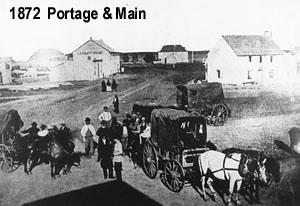 |
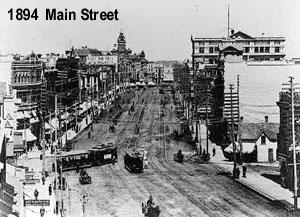 |
| Living and
Work:
Around the early 1900 people started coming to Winnipeg for a better life. Many of the immigrants came from Europe. Some of the countries were England, Scotland, Germany, Austria, Poland, Russian-Germans, and Scandinavia. Reinhardt Yauk, a German-Russ, came with his family in 1912. Peter Hochban came with his family in 1924 from Austria-Hungary. Upon arriving to Winnipeg, immigrants had to endure many barriers and hardships. They lived in a shed for seven days with very un-pleasant conditions. Men, women, and children arrived without money, food, shelter, and most importantly without speaking a new language. After leaving the immigration shed, families were reunited with their own kind of people in other parts of the city. The Germans, Polish, Jewish and Scandinavians started to make their homes beside the C.P.R. tracks in the North End. The English and the Scottish made their homes in the South End. The immigrant men worked in heavy industry such as iron, bridge and steel factories and also helped in the construction of Winnipeg's sewer and water system. In 1911, 3500 men worked for the C.P.R. station. They worked long hours, at hard labour, for low wages. The women worked in clothing factories or sweat jobs in the Exchange District while their children went to public school to learn English and to get an Canadian Education. Note: Kay Yauk (Ken & Norms Mother) worked in one of these clothing sweat shops before marrying John Hochban. She also suplimented the Hochban family income in Toronto by sewing in the sweat shops on Spadina street. |

The Great Depression (1929-1938)
| NOTE: This was the period that John Hochban was riding the rails, in Canada, looking for work. He eventually found a job out of Toronto working for Canada Steamship Lines which carried grain from various ports on the Great Lakes and the St Lawrence River. John's job was to paint the superstructure while the ship was underway. Whan he finished it was time to start all over again on the same structure. He also made contact in Toronto with Standard American, the bathroom fixtures manufacture, which gave him a job in Toronto in 1934. This is how John and Kay Yauk-Hochban eventually arrived in Toronto from Winnipeg. Ken and Norm Hochban were both born in Toronto. |  |
| The crash of the New York Stock Exchange was not the only problem for
Canada in 1929. Much of the nation's bumper crop of wheat could not be
sold, while many other products were doing just as badly. The collapse
came at the worst time, wheat prices fell, and many farms faced foreclosure.
Adding to the problems in the prairies was an eight-year drought and winds
that blew away the topsoil.
Many unemployed men took to riding the rails, travelling across the nation looking for work. They rarely found any, and met with antagonism in many of the small towns they visited. But to many migrants this was a better fate than staying at home and still being jobless. NOTE: As mentioned previosly, John and Kay Hochban had moved to Toronto in 1934 but they did return to Winnipeg with their two children, Ken and Norm, around 1941. This move was essentially made to look after their parents Reinhardt and Katie Yauk and also John's mother Magdalena Hochban. By 1948 John and family moved back to Toronto. |

|
|
 |
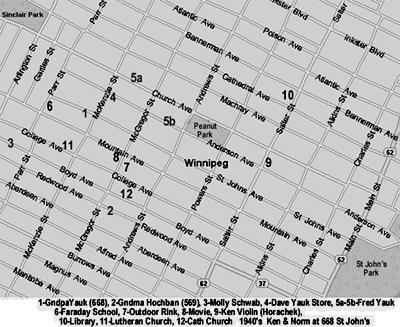 |

Reinhardt |

Back Lane |

Church + |

Dave Yauk |

Fred Yauk |

Lena Hochban |
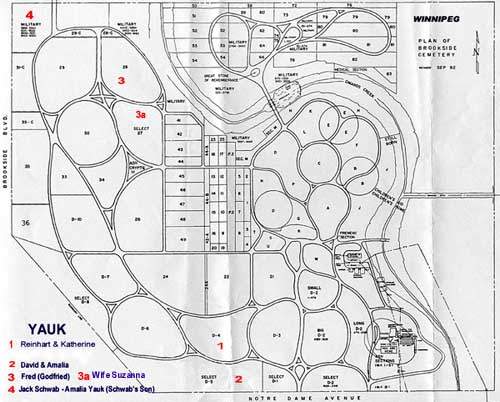
Push Me |
|
|